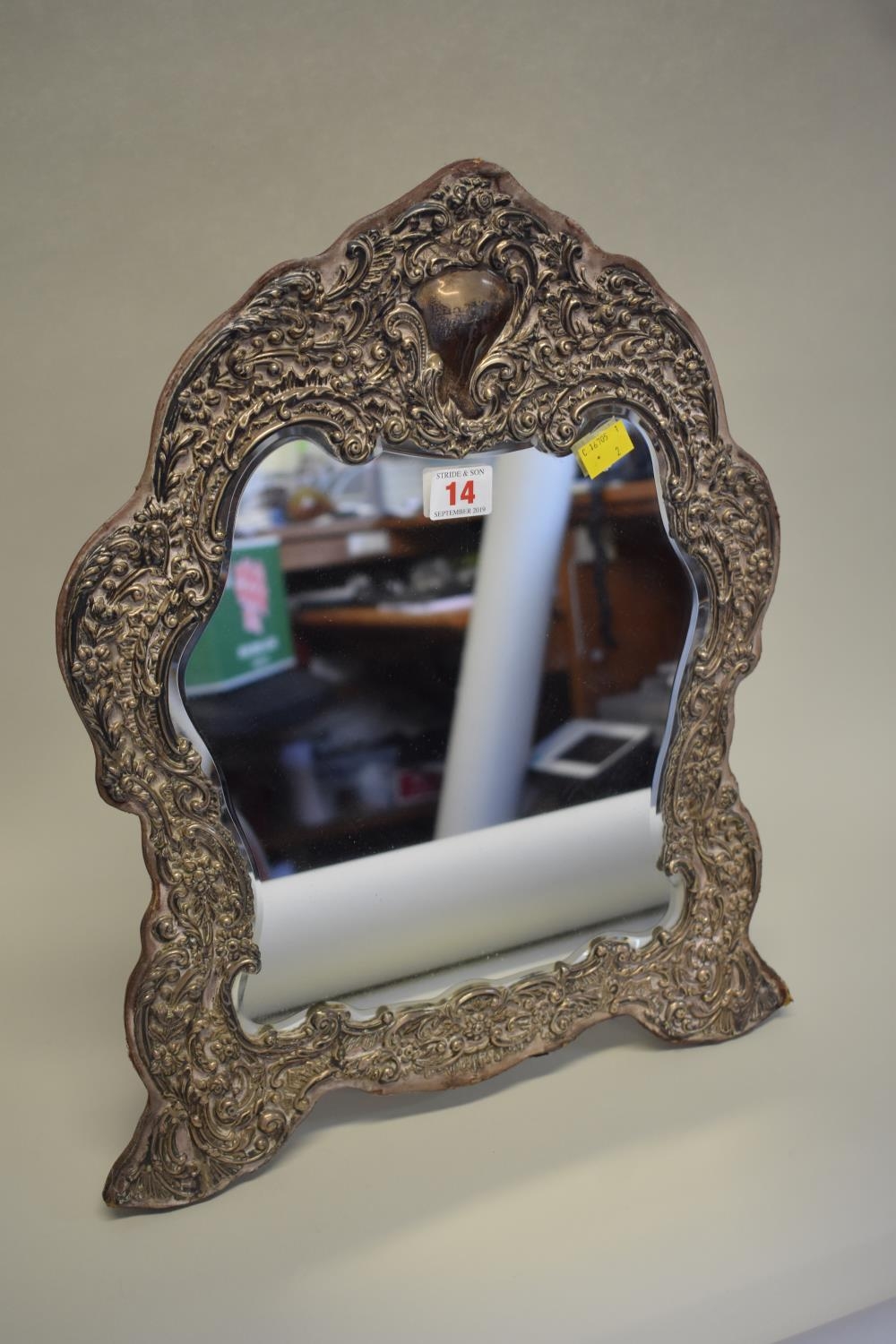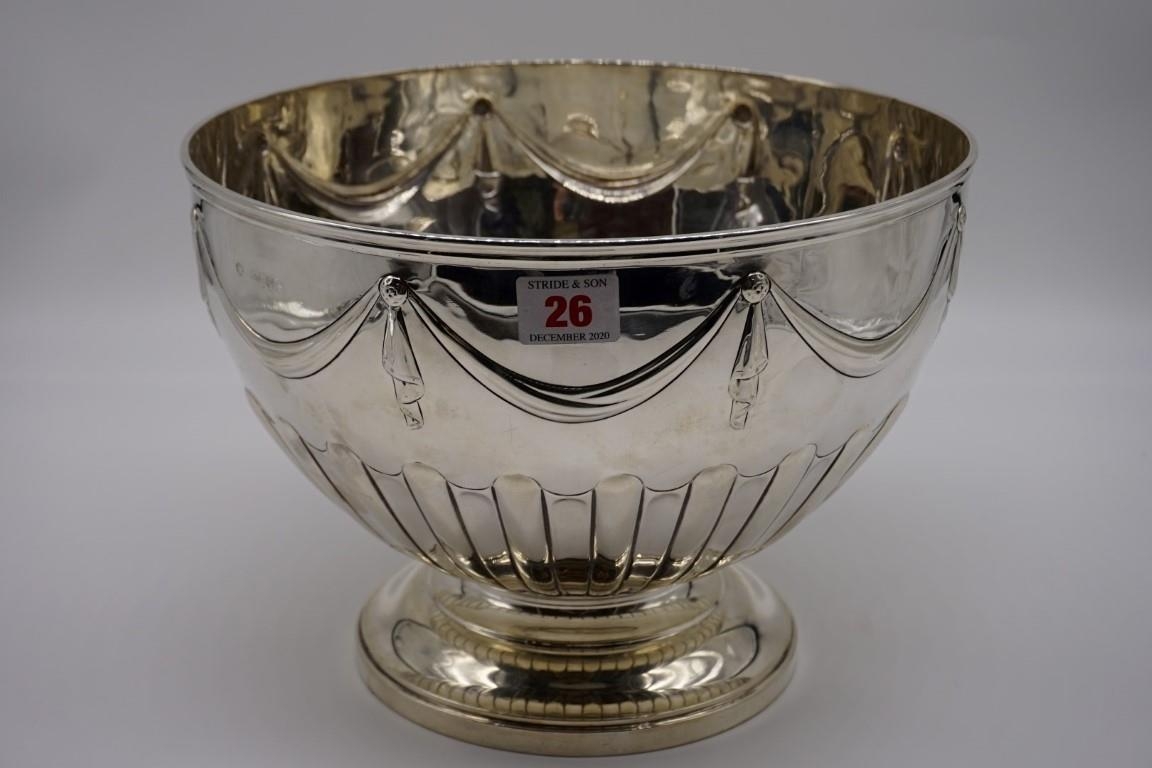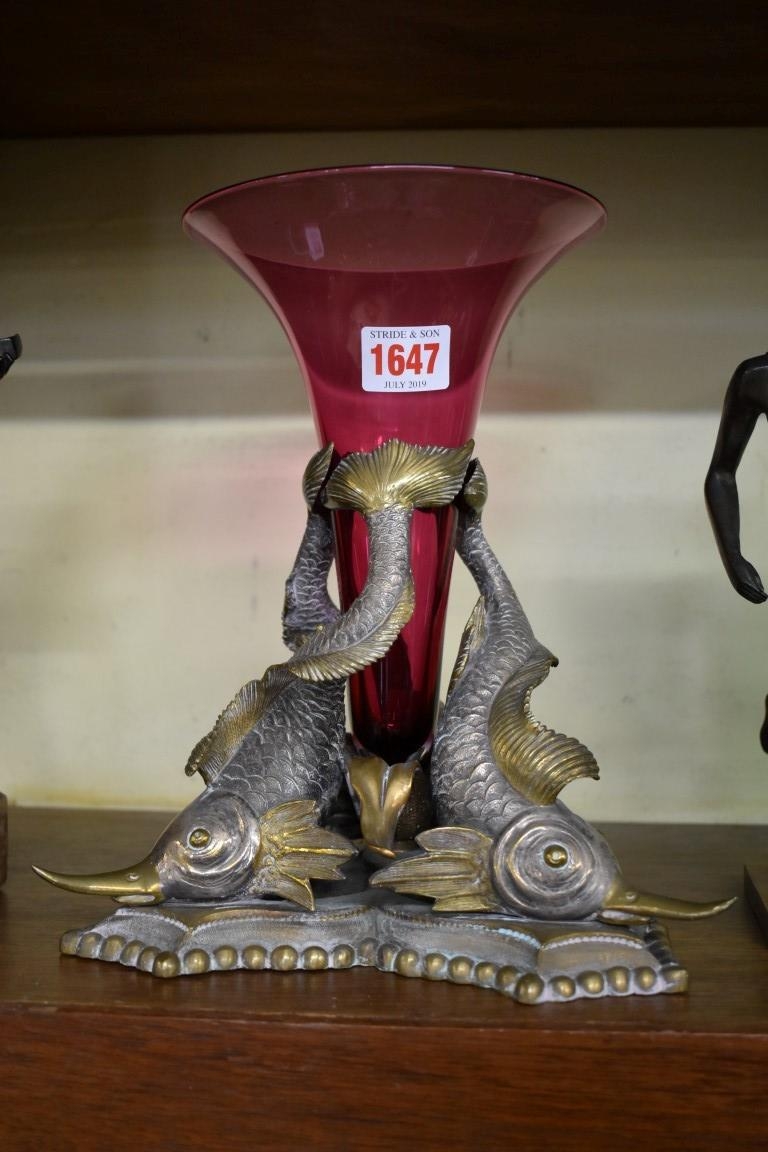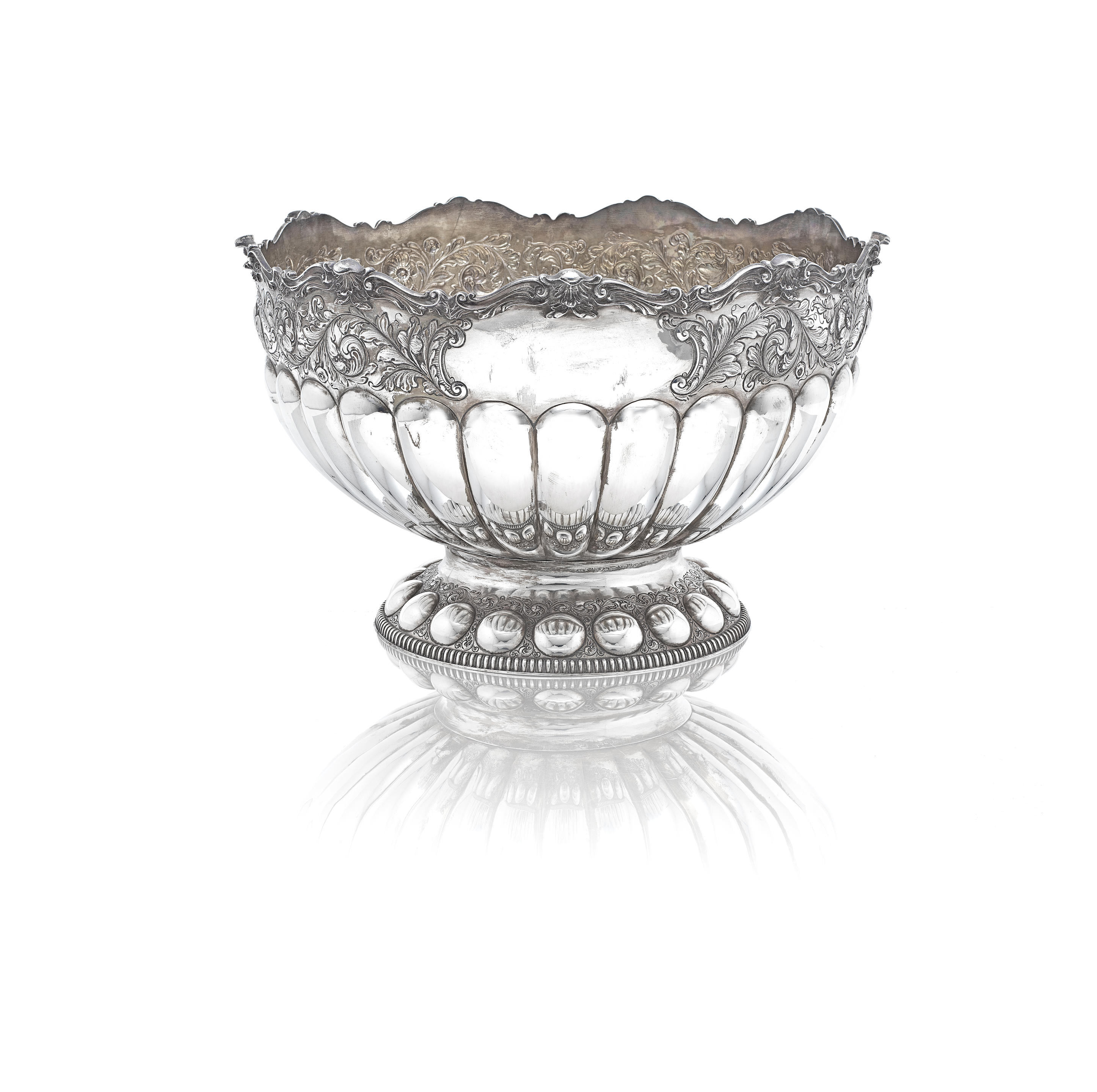An impressive Victorian silver and parcel-gilt presentation vaseCharles Frederick Hancock, London 1868, designed by Raffaele Monti (1818-1881), rim of base also stamped C. F. HANCOCK 39 BRUTON ST LONDON, and with incuse stamp И20 Large squat-baluster jug form, Renaissance style, with long neck flaring out to a wide pouring lip with rolled edges, a polished gilt interior, the fluted high scrolled handle mounted by two winged fighting dragons, mouths snarling baring sharp teeth and serpent like tongue, faces contorted in combat, a dragon's scaly-tail winding down the handle like a corkscrew, the whole decorated with elaborately embossed scrolling foliage and shell-like motifs, burnished and gilded areas juxtaposed against a matt ground, to each side a horizontal oval cartouche featuring a bas-relief of six Bacchanalian putti and a stag's head, to the other five putti hunting with hounds, the main body sitting atop a wide knop interspersed with vertical chased foliate panels and prominent gilded double lobes, a smaller knopped and lobed stem beneath widening to a domed, stepped circular spreading foot, the wide gilt rim highly polished, height 78cm, weight 212oz.FootnotesFollowing the success of the 1855 Exposition Universelle de Paris (otherwise known as the Paris Universal Exhibition or World Fair) and in a bid to rival the London International Exhibition of 1862, Napoleon III (the Emperor of France) organised France's second Exposition Universelle. It was an opportunity to not only demonstrate his political authority on the World stage, but also show off his country's technological and artistic prowess. At the height of his reign, Napoleon III declared that the second major Paris Exposition Universelle would therefore take place in 1867, on the Champ de Mars. Napoleon III hoped that by walking around the Champ de Mars, visitors would feel as though they were travelling around the World all in one day, stating that he wanted to 'make it more universal than the previous ones'. Consequently forty two countries and their colonies participated in the Paris Universal Exhibition of 1867, with each country invited to erect an on-site national pavilion representing their "authentic" national culture and architectural style. The Paris World Fair was a huge success, attracting circa fifteen million visitors in six months. The national pavilion format became an integral part of subsequent international exhibitions, and World Fairs became an international platform for showcasing a country's distinctive characteristics, alongside their agricultural, industrial and artistic strengths. As such, the C. F. Hancock silver presentation vase on offer is interesting on many levels, due to its apparent connection with the 1867 Paris Universal Exhibition, and therefore its part in showcasing English art and industry. The goldsmith Charles Frederick Hancock (British, 1807-1891), the prestigious manufacturing retail silversmith and jeweller of Bruton Street and Bond Street in London, was known for the 'manufacture of plate and jewellery of a superior class, and is extensively patronised by the nobility and gentry, being noted for the taste and quality of its productions. Artists of celebrity are engaged as modellers of groups and designs for surtouts de table and the dressoir, presentation pieces, racing prizes, &c. Among the modellers may be noted especially H. H. Armstead R.A.; C. B. Birch A. R. A.; Signor Raffaele Monti; Eugene Laury and Marshall Wood' (Gilda Aurifabrorum, p.97). Hancock had previously been a partner at Hunt & Roskell, but the partnership had been short-lived and he had left to set up on his own. Such was the quality of his work that on 13th August 1849, only eight months after establishing his own business, he was awarded the Royal Warrant of appointment from Queen Victoria and was blessed with patronage from gentry, celebrities and the nobility of Europe; which included Napoleon III. Major silver manufacturers such as Hancock's, G
An impressive Victorian silver and parcel-gilt presentation vaseCharles Frederick Hancock, London 1868, designed by Raffaele Monti (1818-1881), rim of base also stamped C. F. HANCOCK 39 BRUTON ST LONDON, and with incuse stamp И20 Large squat-baluster jug form, Renaissance style, with long neck flaring out to a wide pouring lip with rolled edges, a polished gilt interior, the fluted high scrolled handle mounted by two winged fighting dragons, mouths snarling baring sharp teeth and serpent like tongue, faces contorted in combat, a dragon's scaly-tail winding down the handle like a corkscrew, the whole decorated with elaborately embossed scrolling foliage and shell-like motifs, burnished and gilded areas juxtaposed against a matt ground, to each side a horizontal oval cartouche featuring a bas-relief of six Bacchanalian putti and a stag's head, to the other five putti hunting with hounds, the main body sitting atop a wide knop interspersed with vertical chased foliate panels and prominent gilded double lobes, a smaller knopped and lobed stem beneath widening to a domed, stepped circular spreading foot, the wide gilt rim highly polished, height 78cm, weight 212oz.FootnotesFollowing the success of the 1855 Exposition Universelle de Paris (otherwise known as the Paris Universal Exhibition or World Fair) and in a bid to rival the London International Exhibition of 1862, Napoleon III (the Emperor of France) organised France's second Exposition Universelle. It was an opportunity to not only demonstrate his political authority on the World stage, but also show off his country's technological and artistic prowess. At the height of his reign, Napoleon III declared that the second major Paris Exposition Universelle would therefore take place in 1867, on the Champ de Mars. Napoleon III hoped that by walking around the Champ de Mars, visitors would feel as though they were travelling around the World all in one day, stating that he wanted to 'make it more universal than the previous ones'. Consequently forty two countries and their colonies participated in the Paris Universal Exhibition of 1867, with each country invited to erect an on-site national pavilion representing their "authentic" national culture and architectural style. The Paris World Fair was a huge success, attracting circa fifteen million visitors in six months. The national pavilion format became an integral part of subsequent international exhibitions, and World Fairs became an international platform for showcasing a country's distinctive characteristics, alongside their agricultural, industrial and artistic strengths. As such, the C. F. Hancock silver presentation vase on offer is interesting on many levels, due to its apparent connection with the 1867 Paris Universal Exhibition, and therefore its part in showcasing English art and industry. The goldsmith Charles Frederick Hancock (British, 1807-1891), the prestigious manufacturing retail silversmith and jeweller of Bruton Street and Bond Street in London, was known for the 'manufacture of plate and jewellery of a superior class, and is extensively patronised by the nobility and gentry, being noted for the taste and quality of its productions. Artists of celebrity are engaged as modellers of groups and designs for surtouts de table and the dressoir, presentation pieces, racing prizes, &c. Among the modellers may be noted especially H. H. Armstead R.A.; C. B. Birch A. R. A.; Signor Raffaele Monti; Eugene Laury and Marshall Wood' (Gilda Aurifabrorum, p.97). Hancock had previously been a partner at Hunt & Roskell, but the partnership had been short-lived and he had left to set up on his own. Such was the quality of his work that on 13th August 1849, only eight months after establishing his own business, he was awarded the Royal Warrant of appointment from Queen Victoria and was blessed with patronage from gentry, celebrities and the nobility of Europe; which included Napoleon III. Major silver manufacturers such as Hancock's, G
.jpg)












Testen Sie LotSearch und seine Premium-Features 7 Tage - ohne Kosten!
Lassen Sie sich automatisch über neue Objekte in kommenden Auktionen benachrichtigen.
Suchauftrag anlegen